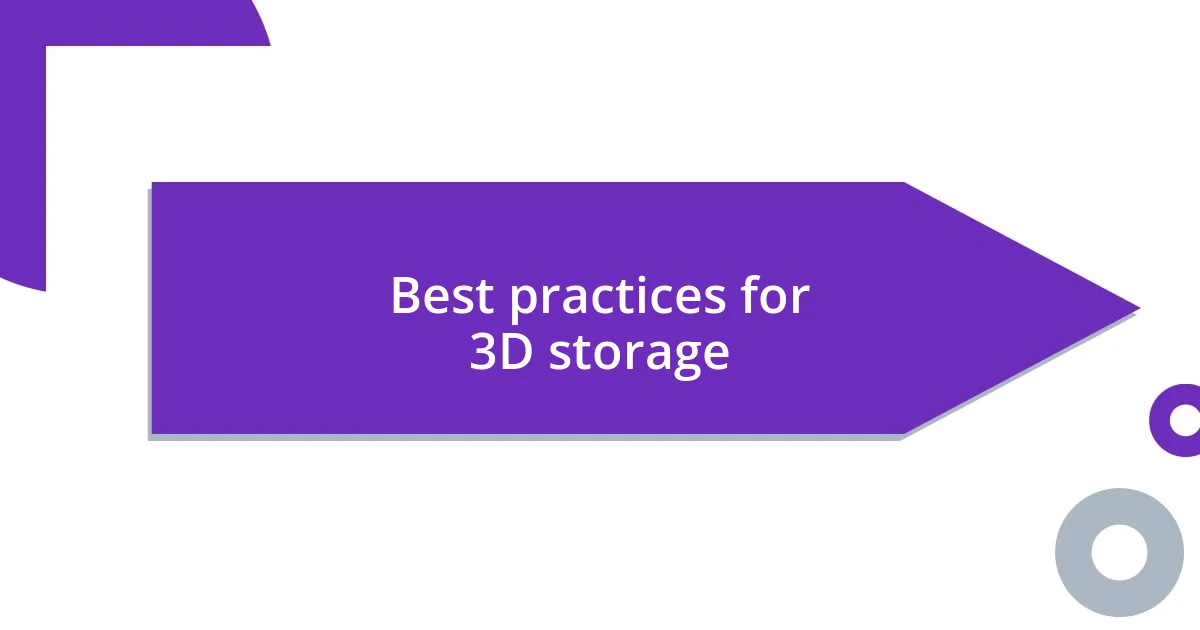Key takeaways:
- 3D storage solutions maximize space efficiency by stacking data vertically, resulting in faster retrieval and improved scalability.
- Choosing the right 3D storage involves careful consideration of data types, cost-benefit analysis, and future scalability options.
- Implementing 3D storage can enhance team productivity through improved collaboration, reduced clutter, and ensuring regular data backups for security.

Understanding 3D storage solutions
3D storage solutions are fascinating because they fundamentally change how we think about space and data. I remember the first time I saw a 3D storage system in action; the efficiency was eye-opening. It was like stepping into the future, where every inch of capacity is maximized, and suddenly, the concept of storage expands beyond traditional bounds.
With 3D storage, layers of data are stacked vertically, allowing for significantly more information to be stored in a smaller footprint. Have you ever wondered how that can impact your day-to-day operations? Personally, I’ve found that these solutions not only save physical space but also streamline access to information, making retrieval quicker and more intuitive.
As these solutions evolve, they offer greater speed and reliability, minimizing downtime in a way traditional systems can’t. I recall a project where implementing 3D storage reduced retrieval time by half, which truly transformed our workflow. Can you imagine the kind of productivity boost that could provide? By embracing this innovative approach, we unlock new possibilities for organization and efficiency in our lives.

Benefits of 3D storage systems
The benefits of 3D storage systems are truly remarkable. One aspect I’ve particularly enjoyed is their ability to adapt to varying storage needs. For instance, during a busy quarter last year, we implemented a 3D storage solution to accommodate a sudden increase in project data. The way it effortlessly scaled up and gave us immediate access to our growing files was nothing short of a game-changer. I felt an incredible sense of relief knowing that we were not going to be bogged down by storage issues.
Here are some key benefits of 3D storage systems:
- Maximized space efficiency: By stacking data vertically, they can store significantly more information in less physical space.
- Faster data retrieval: The streamlined organization allows for quicker access to necessary files, reducing downtime.
- Scalability: These systems can easily adapt to growing storage needs, making them ideal for dynamic environments.
- Improved reliability: They often have enhanced redundancy, ensuring data integrity and minimizing the risk of loss.
- Cost-effective: Over time, the reduction in physical storage space and increased efficiency can lead to significant cost savings.
Reflecting on my own experience, this adaptability has made it easier to manage our workflows, ultimately allowing us to focus on what really matters—delivering quality results to our clients.

Choosing the right 3D storage
When it comes to choosing the right 3D storage solution, I often find myself considering the specific needs of my projects. For instance, the types of data I manage play a crucial role in narrowing down options. I remember selecting a system tailored to our multimedia files because it offered optimized performance in handling large video files. It’s like choosing the right tool for the job—it can make all the difference.
Cost is another significant factor to weigh. I’ve encountered situations where the initial investment for a state-of-the-art 3D storage solution seemed daunting. However, the long-term savings I experienced from reduced physical space and decreased retrieval times made it worth every penny. Have you ever hesitated before a big purchase, only to realize later it was the smartest choice you could’ve made? That’s precisely the kind of feeling I had.
Finally, I’d advise looking into customer feedback and scalability options. During my search, I discovered a system that not only had glowing reviews but also provided the flexibility to expand as our needs grew. That element of future-proofing gave me confidence in my choice. It’s reassuring to know that my storage solution can evolve alongside my work demands.
| Factor | Considerations |
|---|---|
| Data Type | Ensure compatibility with your file types and usage demands. |
| Cost | Consider long-term value against initial investment; savings can accumulate quickly. |
| Scalability | Choose a system that can grow with your needs to avoid future constraints. |

Implementing 3D storage in business
Implementing a 3D storage solution in business can be an exciting journey. I recall the moment we decided to shift to this technology; it was like flipping a light switch. Suddenly, our old storage hassles faded away, and I felt a sense of empowerment as our team started collaborating more effectively. It transformed the way we approached projects, as immediate access to data made brainstorming sessions more productive and less frustrating.
There’s also something refreshing about the physical space aspect. When we first installed our 3D storage system, I remember walking through our office and seeing fewer cluttered shelves and more open areas for creativity. It’s surprising how much of a difference that makes in the workplace atmosphere. Have you ever experienced a similar change in your workspace? The visible shift motivated us all, and our productivity skyrocketed as a result.
As we began using the system, I was particularly impressed by the quick data retrieval speeds. It brought back a memory of waiting endlessly for files to load before—a time-consuming process that felt like watching paint dry. With our new 3D storage, we could instantly access the information. This seamless transition made a challenging project much more enjoyable and left me pondering how much more we could achieve with this newfound efficiency. The results were undeniable—it felt like unleashing our full potential.

Best practices for 3D storage
Best practices for 3D storage focus on organization and regular maintenance. I always prioritize categorizing my files before they go into the system. For example, I dedicate specific areas for different projects, which saves me time when searching for materials later. Have you ever lost precious time sifting through disorganized files? I certainly have. A well-structured approach can eliminate those frustrating moments.
Another aspect I’ve found invaluable is the routine backup process. I remember one particularly hectic week when we lost critical files due to a system glitch. Since then, I’ve made it a point to schedule weekly backups. It gives me peace of mind, knowing that our hard work is safe and retrievable. Do you implement a backup system, or do you live on the edge like I once did?
Lastly, keeping an eye on performance metrics plays a significant role in maximizing efficiency. I make it a habit to review how quickly files are accessed and any delays that might arise. Not only has this helped troubleshoot issues, but it’s also stimulated conversations about upgrades and enhancements. Have you thought about how performance impacts your workflow? In my experience, proactively addressing potential bottlenecks ensures that my projects flow smoothly and efficiently.

Common challenges with 3D storage
When diving into 3D storage solutions, one of the first challenges I encountered was the steep learning curve that often comes with new technology. Initially, I found myself frustrated, navigating through a maze of features and settings I was unfamiliar with. It made me wonder: how do you get employees on board when they’re hesitant about adapting to the unknown? In my case, organizing training sessions worked wonders. It transformed that frustration into a sense of excitement as our team began to see the potential of the system.
Another hurdle I faced was the initial investment cost. I remember hesitating at the price tag, feeling the weight of those budget constraints. Would the benefits truly justify this expenditure? After weighing the long-term efficiencies against the upfront costs, I realized that investing in 3D storage was a strategic move. It’s a reminder that sometimes, a leap of faith can lead to significant rewards, but it requires careful consideration and planning.
Lastly, the issue of data security constantly loomed over my head as I adopted this new system. I vividly recall a colleague sharing a horror story about data breaches that had affected their previous company, making my heart race. It made me question whether I had taken all the necessary precautions. To tackle this, I dove deep into researching encryption and access control measures, which not only alleviated my worries but provided reassurance to my team as well. Have you ever felt the pressure of ensuring data safety? It’s one of those responsibilities that never quite leaves your shoulders but knowing I’ve put protective measures in place gives me a certain peace of mind.














